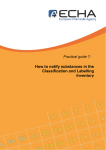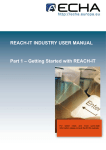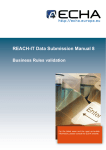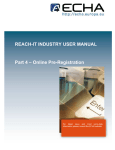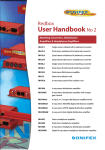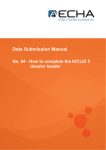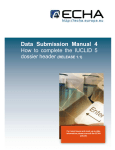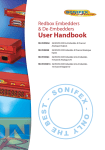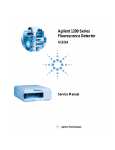Download Data Submission Manual 2
Transcript
Data Submission Manual 2 How to Prepare and Submit an Inquiry Dossier (Release 1.2) For latest news and most up-to-date information please consult the ECHA website Reference: ECHA-08-B-03-EN Date: 15 December 2008 Language: English If you have questions or comments in relation to this document please send those to ECHA helpdesk by using the information request form. The information request form can be accessed in the REACH helpdesk section of the ECHA website at: http://echa.europa.eu/reach/helpdesk/echahelp_en.asp 1 Table of Contents 1. LEGAL ENTITIES ......................................................................................................4 Creating additional official Legal entity......................................................................4 Downloading an official Legal entity and importing it into IUCLID 5 .......................7 Appointing a third party representative .....................................................................11 2. REFERENCE SUBSTANCES..................................................................................12 Querying / updating Reference substances in your inventory....................................12 Creating a Reference substance .................................................................................15 3. CREATING A SUBSTANCE DATASET................................................................19 Assigning a third party representative (if applicable)................................................21 4. ENTERING INFORMATION IN THE SUBSTANCE DATASET .........................23 IUCLID Section: 1 General information ...................................................................24 IUCLID Section: 1.1 Identification .................................................................24 IUCLID Section: 1.2 Composition ..................................................................27 IUCLID Section: 1.3 Identifiers (if applicable) ...............................................29 IUCLID Section: 1.4 Analytical information...................................................31 IUCLID Section: 3 Manufacture, use and exposure ..................................................32 IUCLID Section: 3.3 Sites (as appropriate) .....................................................32 IUCLID Section: 13 Assessment Reports..................................................................34 Attaching files as additional information ..................................................................36 5. CREATING AN INQUIRY DOSSIER .....................................................................39 6. EXPORTING AN INQUIRY DOSSIER...................................................................42 7. UPDATING A DOSSIER .........................................................................................44 Updating the information...........................................................................................44 8. SUBMITTING AN INQUIRY DOSSIER TO ECHA...............................................45 Step 1: Company sign-up in REACH-IT ...................................................................45 Step 2: Submitting an IUCLID 5 inquiry dossier .....................................................46 2 INTRODUCTION The purpose of this manual is to assist in the preparation of an inquiry dossier using IUCLID 5. The manual assumes that IUCLID 5 has been installed and that you have a user account assigned to the Legal entity created during the installation of IUCLID 5. If IUCLID 5 has not yet been installed, please consult the IUCLID 5 web site available at http://iuclid.eu. On this web site, you can download the software free of charge, and also find more comprehensive guidance about the use of IUCLID 5. This manual provides a stepwise approach for the preparation and submission of an inquiry dossier: 3 1. LEGAL ENTITIES The “Legal entities” are used in IUCLID 5 to provide contact details on the companies involved in processes under REACH. In the case of an inquiry, it is necessary to define the Legal entity of the inquirer. There are two types of Legal entities that can be created in IUCLID 5: • “Official” Legal entities are created on the IUCLID web site, for which a central management of company identifiers (UUID) is available: it enables you to subsequently identify the company in an unequivocal manner. In general, companies owning and/or submitting the data or the dossiers should be official Legal entities; • “Non official” Legal entities are created directly in IUCLID 5 for which there is no central management on the IUCLID web site of company identifiers. These should be used only in cases where an unequivocal identification of companies is not critical, e.g. for reporting information on a non EU manufacturer. It is, however, recommended to use, as often as possible, the “official” Legal entities obtained from the IUCLID web site or directly from the companies owning them. A potential registrant under REACH must submit to the European Chemicals Agency (ECHA) certain information, in particular his own contact details. Therefore you will be required (if you have not already done so) to create, on the IUCLID 5 web site, an official Legal entity for the potential registrant. The creation of an official Legal entity takes place during the installation and downloading of IUCLID 5 (for more details on how to download and install IUCLID 5 refer to http://iuclid.eu). Additional official Legal entities can be created in the IUCLID 5 web site and imported into your IUCLID 5 installation. If the official Legal entity you wish to link to the substance is a different Legal entity as the one specified during the IUCLID 5 installation you will need to create this official Legal entity. Creating additional official Legal entity • Go to http://iuclid.eu. Click the “Get IUCLID 5” tab and sign in with your username and password. You will then see the following screen: 4 • Click “Create new LEO”. 5 • Complete as many of the fields as possible. In addition to the Company name, it is important that in the “Organisation information – Legal entity contact” block, the following fields are completed: o Phone and/or Fax number o E-mail address o Street o Postal code o City/Town o Country • Click the “Next” button. • In the “Organisation Information – Contact Person” complete as many of the fields as possible. In particular it is important that the following fields are completed: o Organisation o First Name o Last Name 6 o Phone and/or mobile and/or fax number o E-mail address o Street o Postal code o City/Town and/or Region/County o Country. • Click the “Submit” button. • You have now created your official Legal entity. Downloading an official Legal entity and importing it into IUCLID 5 • Click the “Get IUCLID 5” tab from the IUCLID 5 home page and click “Your LEOs” link. 7 • Click the “Download” link. You will download a “Legal entity Object” (or LEO) that contains the information of your official Legal entity. However, it is still not linked to your local IUCLID 5 installation. • In the main task panel of IUCLID 5, click “Import”. Note: this import procedure applies to Legal entities other than your own one under which you have executed the installation process of IUCLID 5. • Use the browser window to select the new LEO you created. • Click the “Next” button in the following windows. A confirmation message will appear. Click the “Finish” button. 8 • Now you have to assign this new entity to your user. Go to “User management” in the main task panel. • In the user management screen select the user to which you want to associate this new official Legal entity. • Now go to “Assign Legal entities” and click the button. A query window will appear. Type the name of the official Legal entity you want to assign to the user selected and click the “Search” button. Be sure to uncheck the checkbox "Show only active values" because newly imported Legal entities are by default marked as inactive. 9 • Right-click the Legal entity you want to assign. If the checkbox for “Active trade partner” is not checked, click “active trade partner” to activate it. Then click “Assign”. • Click the “Save” button to save the changes. This change will only be active the next time you log in, so you may need to re-initialise IUCLID 5. 10 • The next time you log into IUCLID 5 as that user, the new Legal entity will be assigned to your user account. • Where you have assigned more than one official Legal entity to the same user, you may switch between them by clicking on the name of the Legal entities at the bottom of the main screen. The substances and dossiers created will, by default, be associated to the entity selected in this box. Appointing a third party representative If you wish to appoint a third party representative (TPR) to deal with discussions with other manufacturers, importers or where relevant downstream users the third party representative must have an official Legal entity created in IUCLID 5 and he must sign-up in REACH-IT. During the sign-up in REACH-IT he must import the LEO created in IUCLID 5 into REACH-IT. For further information on how to assign a TPR to your inquiry please refer to Chapter 3 of this manual. 11 2. REFERENCE SUBSTANCES To correctly identify the substance you wish to inquire about, it is important to understand the concept of substance, Substance dataset and Reference substance in IUCLID 5. The inquiry dossier is prepared for a substance (a substance is defined under Article 3(1) of the REACH Regulation. In IUCLID 5, the information related to that substance (such as the identity of the substance, its composition, etc) should be specified in the Substance dataset created for that substance. To insert information on the identity of your substance and its constituents in the Substance dataset, you will need to use the concept of Reference substance. A Reference substance is nothing more than a link to the identity of a chemical. The concept of a Reference substance enables you to store identification information on a given substance or a given constituent of a substance, such as chemical names (EC name, CAS name, IUPAC name, synonyms, etc), identity codes (e.g. EC number, CAS number), molecular and structural information, in a central place. This information can then be re-used in other datasets without having to retype the information. The Reference substance inventory is directly maintained by you, in your local installation. To extend the number of entries in your Reference substance inventory, we recommend you to download the ca. 70,000 pre-filled Reference substances from the IUCLID 5 web site and import them to your local installation (unless already done so during the IUCLID 5 installation). These pre-defined Reference substances have been prepared to improve data quality and minimise data entry. In addition, you should also download an EC inventory from the IUCLID 5 web site (unless already done during the IUCLID 5 installation). This inventory consists of a list of substance identities which is based on a combination of the following EU inventories: EINECS, ELINCS and NLP-list. When creating a new Reference substance with an EC number, you can minimise data entry and ensure data quality by extracting the data from the EC inventory. In this section of the manual, you will find the procedure to be followed for searching, updating and creating the Reference substances to be assigned to your substance directly from the main task panel. Note that it is also possible to create a Reference substance directly from the Substance dataset (Chapter 4). Querying / updating Reference substances in your inventory • Click “Update” under “Reference substance” on the main task panel. 12 • If during the installation of IUCLID 5 you have chosen to download and install the Reference substance inventory, you will have approximately 70,000 Reference substances stored in your computer. A warning will appear, indicating that the default query limit is 500 items. If you answer “Yes”, the query for all Reference substances will be skipped the next time you update the inventory. If you answer “No”, IUCLID will retrieve the full list of Reference substances the next time you choose to update the Reference substance inventory. Either way, you will be redirected to the Reference substances screen. • Click the “Query” button. • A dialog box will appear. Select “Find Reference substances” from the “Select query” picklist. • Type the search criteria for the substance you are looking for and click “Search”. You can use the asterisk (*) as a wild card. For example, to get all the substances starting with “phenol” you would type “phenol*”. To get all 13 the substances ending in “amine” you would type “*amine” (note that only 2000 results will be shown). • Double click the Reference substance to display the related data 14 • Check the data on the Reference substance. To update/add any information on the Reference substance, click the “Edit item” button ( ) in the toolbar on the top of the screen, edit the information on the Reference substance, and save the changes. Creating a Reference substance If you do not find in your Reference substance inventory the Reference substance you need, you can create it following this procedure: • In the main screen, go to inventories and click “New” under “Reference substance”. • Type the name of the Reference substance in the “Reference substance assistant” pop-up window. The box “Active Reference substance” should be checked, as only Reference substances marked as “active” can be used during the creation of a Substance dataset. • Select the "Finish" button; the Reference substance is created and an empty Reference substance section appears. Click the “Edit item” button. 15 • If the Reference substance is listed in the EC-inventory: o Assign that entry by clicking the button. The query dialog appears in which EC inventory entries can be searched. o Search using any of the criteria listed, such as the EC name of the substance. Again, you can use “*” as a wild card. 16 o Highlight from the list the entry that matches your Reference substance. o Click the “Assign” button. The information for this Reference substance will be included in your new Reference substance. • If your Reference substance is not in the EC inventory, select a justification from the picklist proposed under the “No EC information available” section. • Complete as far as possible the remaining fields of the Reference substance. When completing the information for your Reference substance, the following information should be submitted for all the known constituents and impurities: - EC number and EC name (if available) - CAS number and CAS name (if available) - IUPAC name - Description (specify any additional information relevant for the description of the Reference substance in this field). - Molecular formula (if a molecular formula cannot be derived from the Reference substance, a justification should be indicated in the “Remarks” field at the bottom of the screen) - Molecular weight range (if applicable) - SMILES notation (if applicable) - InChI (when available) (if applicable) - Structural formula (if applicable) 17 For the structural formula, go to “Structural formula”, under “Molecular and structural information” and click the “Add” button. You can then upload an image file with the structural formula. 18 3. CREATING A SUBSTANCE DATASET To create an inquiry dossier in IUCLID 5, you need first to create a Substance dataset. A Substance dataset is the repository of data, which is used as a basis to create the dossier to be submitted to the ECHA. • On the IUCLID 5 Task Panel, under Tasks, select “New” from Substance. • Type the name of your substance for which you wish to inquire about. The name can be anything, but it is logical to use an identifier that you are familiar with such as a trade name or chemical name. • Click the "Next" button. Select the Legal entity to be assigned to the Substance dataset. Note: If the Legal entity to be linked to the Substance dataset is not available from the picklist, a new Legal entity should be assigned to the user. For this purpose, please refer to the instruction provided in the “Creating an official Legal entity” and “Downloading an official Legal entity and importing it into IUCLID 5” sections above. • Click the "Finish" button. You have now created a Substance dataset. 19 • The section tree of your Substance dataset is displayed in the navigation part of the screen (to see the complete tree view click the button and select “expand all” from the pop-up menu). • IUCLID 5 also offers the possibility of highlighting sections that are suggested for completion to assist in the preparation of various types of dossiers. However, this feature is not currently available for an inquiry dossier, therefore click the button and select “Complete” from the picklist. • “Complete” is a generic template and not specific to inquiry. 20 Therefore IUCLID 5 marks all sections in green meaning it suggests they are optional. The sections that should be completed as a minimum for inquiry are sections 1.1, 1.2, 1.3, 1.4, 3.3 and 13. The detail required to complete each of these sections is explained later in this manual. Assigning a third party representative (if applicable) If you wish to appoint a TPR to deal with discussions with other manufacturers, importers or where relevant downstream users, you will need to get from the TPR, or create on their behalf on the IUCLID 5 web site, an official Legal entity. You would then need to import the TPR official LEO into your local IUCLID installation using the procedure described under “Downloading an official Legal entity and importing it into IUCLID 5”. The procedure to assign the official Legal entity to your Substance dataset is as follows: • Click the below. button next to the third party as circled in the screenshot • A “query” dialog appears. • Ensure the “Official Legal entity” and “Show only active values” checkboxes are checked. • Using the search criteria, search for the third party you wish to assign to your Substance dataset. • Highlight it from the list presented and click the “Assign” button. 21 • A third party has now been assigned to your inquiry. 22 4. ENTERING INFORMATION IN THE SUBSTANCE DATASET Once you have created a Substance dataset for your substance that has been assigned to the Legal entity of the inquirer, you can enter data on the substance in this dataset. The information required to be included in the Substance dataset is described in the REACH regulation (Article 26(1)) and the associated Data Sharing guidance available on the ECHA website (http://reach.jrc.it/guidance_en.htm). Note also that further information on the description of substances in IUCLID 5 is available in the Guidance for Identification and Naming of substances under REACH. This guidance is also available on the ECHA website. To retrieve the Substance dataset you have already created, click “Update” under “Substance” in the main task panel, and select your substance from the list by double clicking it (note: to facilitate the retrieval of your Substance dataset, you may either use the filtering system by typing the name (or part of it) of the substance in the query field or use the query system by clicking the “Query” button).. Once the substance is displayed in the data entry pane, expand the section tree (by clicking the “Section tree” tab) and proceed to complete the necessary sections. Double click in each section to display it, and click the “Edit item” button in the upper part of the screen to complete the fields. 23 IUCLID 5 Section: 1 General information IUCLID 5 Section: 1.1 Identification Name of the substance • In “Reference substance” click the substance” to your substance. button to assign a “Reference • A query dialog appears. Search for your “Reference substance”. • Highlight the Reference substance from the result list and click “Assign”. 24 Note: It is possible that the Reference substance already exists but you have not set it as “Active”. In this case, untick the “Show only active values” checkbox to display both the Reference substances marked as active and inactive. Right-click the non activated substance you want to assign. Click the “Active trade partner” to activate it. Then click “Assign”. • If you cannot find your Reference substance because it has not been created yet: o Click “New” to create a new Reference substance. 25 o You will be redirected to the “Reference substance assistant” o Type the name of the Reference substance you need to create and click the “Finish” button. o To specify the information on the new Reference substance, click the blue arrow button. o You will be redirected to the screen for the new Reference substance. Complete all the possible fields as described in the chapter 2 “Creating a Reference substance". o Click the “Save” button. button to go back to the substance (save when o Click requested). • Fill in manually all the fields (again, you should complete as many as possible). • The buttons next to the fields “Composition” and “Origin” allow you to choose from picklists. • The button “Add” ( ) allows you to create additional repeatable blocks where to add trade names. Contact person Although the contact details of your company are specified in the “Legal entity”, you can also indicate the information details of the contact person for that specific substance. Complete as many of the fields as possible. 26 IUCLID 5 Section: 1.2 Composition • Double click section 1.2 (Composition) and click the “Edit item” button. • Click the “Add” button . • Write the name and a brief description of your substance. • Complete the “Degree of purity” section. The degree of purity to be specified should correspond to the purity of the main constituent(s) of the substance. The drop-down list box allows you to pick symbols or units from a picklist, and the boxes allow you to type numbers. In this part you can give the normal range of purity for the substance. For instance, a substance with purity between 95-98% (w/w) will be given as shown below. • Open the constituents’ repeatable block (by clicking the “Add” button ). • Assign a “Reference substance” to the newly created constituent by clicking the button, as described above. Search for the appropriate 27 Reference substance and add it by selecting it and clicking “Assign”. Create the Reference substance you need if it was not created in advance. • Indicate the typical concentration and the concentration range for every constituent in the same manner as indicated above. • If you need to specify more than one constituent, click the “Add” button in the relevant section, and more boxes will appear. • Follow the same procedure to complete the impurities and additives fields. 28 IUCLID 5 Section: 1.3 Identifiers (if applicable) In this section you can add identifiers for other regulatory programmes or IT systems. In particular, if the substance for which you are submitting an inquiry has previously been subject to a product and process orientated research and development (PPORD) notification or is an inquiry based on Article 12(2) of the REACH Regulation, it is recommended that you report the PPORD notification number or notification number or registration number: • Open the section 1.3 of the IUCLID 5 Substance dataset by double clicking on “1.3 Identifiers” from the tree view and click the “Edit item” button. 29 • In the “Regulatory programme identifiers”, select “Add” to edit the list of identifiers. A pop-up window entitled “Regulatory programme identifier” appears on the screen. In “Regulatory programme identifier” box, complete the fields as follows: - “REACH PPORD number” or “notification number (NONS)” or “REACH registration number” should first be selected as regulatory programme. The number should be specified in the “ID” field. • By clicking the “OK” button in the “Regulatory programme identifier” window, the regulatory identifiers will appear as a list. 30 IUCLID 5 Section: 1.4 Analytical information • In the section tree of your Substance dataset, double click the section “1.4 Analytical information” and click the “Edit item” button. • Under the “Analytical method” field, describe the analytical methods used to characterise your substance, and where appropriate, the impurities and additives. You can also attach such information by clicking the button (note that you can only attach one file in each field). • Under the “Optical activity” field, provide information on the optical activity and typical ratio of (stereo) isomers, whenever applicable. • Provide the analytical results used to characterise the substance, such as spectral data (UV, IR, NMR, MS, etc.), chromatographical data, etc. For each analysis, click the button to add a new repeatable block, and enter the analysis type, the test substance, the method used and any remark you consider relevant. For each analysis you can also attach one file by clicking the button. 31 IUCLID 5 Section: 3 Manufacture, use and exposure IUCLID 5 Section: 3.3 Sites (as appropriate) Use this section to indicate the Site where production of your substance takes place. First, you should create those Sites in the relevant section of the main task panel. Creating a Site • On the main task panel click “New” under “Legal entity site”. • The Site assistant will appear. Type the name of your site. • Assign the Legal entity of the notifier to the Site and click the “Finish” button. • The Legal entity screen will appear. Indicate the address of your Site, as well as the contact details and other IT identifiers. 32 • Click the “Save” button. You have now created a production site linked to the Legal entity. Assigning a site • In the section tree of the Substance dataset, double click “3.3 Sites” and click the “Edit item” button. • Create a new repeatable block clicking the button. The fields where the information on the production site can be specified are now displayed. • Click the button to link the Sites assigned to your Legal entity will appear. Select the site and click the “Ok” button. 33 • Tick the “Production site” checkbox. • If you need to indicate more production sites, click the repeat the procedure described above. button and IUCLID 5 Section: 13 Assessment Reports Use this section to attach the information requirements which would require new studies to be carried out (Art 26 (1) (c) and (d)). To do this you first need to complete the “Inquiry - information requirements form” available on the ECHA website (http://echa.europa.eu), download it and save it. You then need to attach it in IUCLID 5 as part of the Substance dataset as follows: • Right-click section “13 Assessment Reports” and select “New endpoint study record” 34 • A “New endpoint study record” section appears. Re-name the new endpoint study record to “Information requirements which would require new studies” and click the “OK” button”. • In the next screenshot, shown below, from the picklist under “Type of report” select “other” and in the adjacent box type “Inquiry”. • In the “Remarks” field type “In accordance with Art 26 (1) (c) and (d) I attach the list of information requirements that would require me to conduct new studies”. Alternatively, if you have no information requirements that would require new studies to be conducted, in the “Remarks” field type ”No information requirements requiring new studies to be conducted” • In the “document” field click the button and the “Add” button that appears. You may be requested to save at this stage, which you should do. You can then attach the document. You do not need to attach this 35 form if you have no information requirements requiring new studies to be conducted. Attaching files as additional information • At the bottom of the Substance dataset screen, a window called “Information” is minimised by default. Click the button to maximise it. • The information screen will appear. Click the tab “Attachments”. • To add an attachment, click the “Edit item” button, right-click the white left field and select “Add”. 36 • The system will ask you to save the working document. Accept, and the browsing box will appear. Select the file to attach and click “Open”. • Write remarks on the file if you wish, and click “Save”; the attached file will appear. • Repeat the previous steps to attach more files. 37 • Once the necessary attachments have been added to the Substance dataset, click the "Minimise” button entry data pane. to visualise the Substance dataset 38 5. CREATING AN INQUIRY DOSSIER On the IUCLID 5 Task Panel, select “Update” from Substance. • All available substances are displayed; select the substance for which you want to create the Inquiry dossier. • Right-click a substance in the query results list. From the pop-up menu select “Create Dossier”. • The Dossier creation wizard is displayed. • Step 1: Select the Dossier template “Complete” Note: The dossier template selection helps to determine which IUCLID 5 section and endpoint studies will be part of your dossier. However, there is currently not such a template for inquiry and therefore you will need to select the generic “Complete” template. 39 • Step 2: Define the filters. Every item that matches these filters will be taken into account for the dossier. The “Select all” button allows you to select all possible items at once. • Step 3: See the state (full, partial…) of all documents taken into account for the dossier creation. At this stage, please be sure that all the necessary sections for your inquiry Dossier appear ticked, as only these documents will appear in your dossier. The relevant sections for inquiry are 1.2, 1.3 (as appropriate) 1.4 and 3.3. • Step 4: check that all related objects will be part of your Dossier (Legal entity, Reference substance(s) and endpoint study record(s)). • Step 5: In the field “Name”, type the substance name the inquiry relates to, and in the “Dossier submission remark” field type “Inquiry dossier”. If your inquiry is as a result of an update of your registration due to a tonnage band increase (Article 12(2) of the REACH Regulation) in this field type “Inquiry as a result of an update of a registration”. If your substance is a non-phase-in substance legally on the market before June 2008 (see 9th of June ECHA press release (ECHA/PR/08/12) available on the ECHA website at http://echa.europa.eu/news/press_en.asp) type “Inquiry dossier for nonphase-in substance legally on the market before June 2008” in the “Dossier submission remark” field. In this field you must also give a justification as to why such placing on the market was considered lawful. 40 • A window informs about the success of the import. When clicking the “View dossier” button, the Dossier will be displayed. 41 6. EXPORTING AN INQUIRY DOSSIER • The inquiry Dossier needs to be exported in order to be sent to ECHA. • In the main screen click in the dossier icon or the “view” link. • Select your inquiry Dossier, right-click it and select “Export”. • The Export assistant will ask you if you wish to include your annotations in the dossier. Normally, select “Export without annotations” (unless you have included relevant information as annotations in your Dossier) and click the “next” button. 42 • In the next step specify the location where you want to store your Dossier by clicking the button. • Now click the “Finish” button. The Dossier has now been exported to the location you specified; a confirmation message will appear. 43 7. UPDATING A DOSSIER Updating the information If you need to submit further information on your inquiry Dossier, be it as a result of missing information, lack of quality or inability to verify the substance identification, you do not need to re-type again all your substance data. • In the main screen go to tasks, and click “Update” under “Substance”. • Select from the list, the substance for which you wish to submit new information, and double click it. From the Substance dataset tree view, select the section(s) that you wish to update. Edit the necessary sections by clicking the “Edit item” button ( ). To create and export the Dossier, please refer to Chapter 5 and 6 of this manual. 44 8. SUBMITTING AN INQUIRY DOSSIER TO ECHA Step 1: Company sign-up in REACH-IT If you do not have an account in REACH-IT, refer to the Industry User Manual – Part 2, in http://echa.europa.eu/reachit/createaccount-it_en.asp) or follow the instructions in this section. • Go to the ECHA website (http://echa.europa.eu/) to access REACH-IT. • In REACH-IT, click on “sign-up as a company”. • In the following page, you will be required to accept the terms and conditions in order to proceed with the sign-up procedure. If you agree with the terms and conditions, click on “accept”. 45 • Follow the sign-up procedure. Signing-up as a company is a simple process. You will be guided through the following 5 steps: o User account - Create your REACH-IT user account. o Company information - Provide general information on your company. For consistency, you should import the LEO created in the IUCLID 5 website, which was linked to the substance for which the IUCLID 5 inquiry dossier was made (See IUM- Part 1). o Billing information - Provide billing details for your company. o Contacts – In this screen you can specify contact persons for your company. o Validation - Check the information you have provided and modify if necessary. Step 2: Submitting an IUCLID 5 inquiry dossier Please refer to the Industry User Manual – Part 6 – Dossier Submission, available at http://echa.europa.eu/reachit/manuals_en.asp 46 ANNEX I: Update of the document: I. Update of version 1.1 Page Change made 5 Text amended as follows; An inquirer potential registrant under REACH must submit to the European Chemicals Agency (ECHA) certain information, in particular his own contact details. Therefore you will be required (if you have not already done so) to create, on the IUCLID 5 web site, an official Legal entity for the inquirer potential registrant. 39 The following text added; Alternatively, if you have no information requirements that would require new studies to be conducted, in the “Remarks” field type ”No information requirements requiring new studies to be conducted” 40 The following text added; You can then attach the document. You do not need to attach this form if you have no information requirements requiring new studies to be conducted. 44 The following text added; If your substance is a non-phase-in substance legally on the market before June 2008 in the “Dossier submission remark” field type “Inquiry dossier for non-phase-in substance legally on the market before June 2008”. In this field you must also give a justification as to why such placing on the market was considered lawful. II. Update of version 1.2 Page Change made 3435 Text amended to explain how to indicate the inquiry is based on Article 12(2) 45 Text amended to read as follows: “Step 5: In the field “Name” please type the substance name the inquiry relates to and in the “Dossier submission remark” field type “Inquiry dossier”. If your inquiry is as a result of an update of your registration due to a tonnage band increase (Article 12(2) of the REACH Regulation) in this field type “Inquiry as a result of an update of a registration”. If your substance is a non-phase-in substance legally on the market before June 2008 (see 9th of June ECHA press release (ECHA/PR/08/12) available on the ECHA website at http://echa.europa.eu/news/press_en.asp) in the “Dossier submission remark” field type “Inquiry dossier for non-phase-in substance legally on the market before June 2008”. In this field you must also give a justification as to why such placing on the market was considered lawful.” 50 Text deleted in reference to submission using temporary procedures 47 48 European Chemicals Agency Annankatu 18, P.O. Box 400, FI-00121 Helsinki, Finland Tel.: +358 9 6861 80 | Fax +358 9 6861 8210 | http://echa.europa.eu | [email protected]


















































